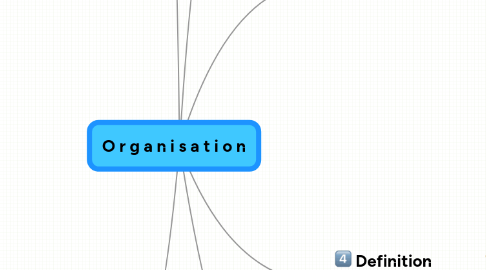
1. Types of Organisation
1.1. Public Sector
1.1.1. Providing Welfare / Essential Goods
1.1.1.1. Government Department
1.1.1.2. Government Companies
1.1.1.2.1. Such as: - Government Investment Corp, Singapore - Singapore Technologies - Temasek Holdings
1.1.2. Mixed economy
1.1.3. Needs protection from competition
1.1.4. Prevents FDI
1.2. Non-Profit
1.2.1. - SPCA - Charitable
1.3. Private Sector
1.3.1. Profit Seeking / Money orientated
1.3.1.1. Companies / Corprations
1.3.1.1.1. Private Ltd
1.3.1.1.2. Public Ltd
1.3.1.2. Partnership
1.3.1.3. Sole Proprieter
1.4. Privatisation
1.4.1. process of selling public assets to the private sector
1.4.2. example: Singapore Airlines, Singtel
1.5. Deregulation
1.5.1. Lifting of government control over industries in order to encourage foreign direct investment (FDI) and competition
1.5.2. Industry examples: - Banking/Finance - Media - Telecommunications - Utilities - Postal - Life Sciences
2. 5 approaches to the study of organisation
2.1. economic approach
2.1.1. MC = MR concept marginal cost = marginal revenue = output
2.2. behavioural theory
2.2.1. seeks to satisfy participants (stakeholders) to gain their support for organisations' strategy
2.2.2. Organisation
2.2.2.1. customers
2.2.2.2. suppliers
2.2.2.3. shareholders
2.2.2.4. employee
2.3. Agency approach
2.3.1. manager acts as an Agent where top management has delegated decision-making to him/her
2.3.2. agent manages in the best interest of the top management (principal)
2.3.3. Agent also satisfies his personal interest (wages/compensation)
2.4. Transaction costs Theory
2.4.1. Incur Transaction costs -------------------------- - monitoring costs - enforcing costs - negotiation costs
2.4.1.1. Once transaction costs reach a certain point of high level, then third party should be replaced. outsource these activities ( photocopying/call centres) with the purpose to improve internal efficiency
2.5. Economic Approaches to Strategic Management
2.5.1. Decisions are made using Game Theory (Oligopolistic Industry)
2.5.2. Decisions are based on the assumptions of behaviour of rival firms & using quantitative method
2.5.3. Decisions are made rationally
3. Purpose
3.1. Arrive at an acceptable definition of an Organisation
4. Definition
4.1. A social entity that provides the necessary structures to achieve specific aims
4.1.1. Social Entity
4.1.1.1. Living things Organisms
4.1.2. Structures
4.1.2.1. Organic
4.1.2.1.1. Flexibility
4.1.2.1.2. Ability to implement change easily
4.1.2.1.3. Open to suggestions
4.1.2.1.4. Freedom
4.1.2.1.5. Flat Structure
4.1.2.2. Mechanistic
4.1.2.2.1. Bureaucracy
4.1.2.2.2. Resistant to change
4.1.2.2.3. Example: Banks, Armed Forces
4.1.2.2.4. Tall Structure
4.1.3. Specific Aims
4.1.3.1. Too general
4.1.3.2. Too generic
4.1.3.3. Does not address the issues of the public, private sector and non-profit organisations individually
5. Definition
5.1. A commercial enterprise or establishment that trades in goods & services
5.1.1. Commercial Enterprise / Establishment
5.1.1.1. profit making
5.1.1.2. profit seeking
5.1.2. Trades
5.1.2.1. Transactions between 2 or more parties - could be in kind or monetary means
5.1.3. Limitation
5.1.3.1. Definition excludes non-profit and public sector organisations
6. Definition
6.1. An entity that is both commercial & social, that which provides the necessary structures to achieve the central objective of trades in goods and services
6.1.1. entity
6.1.1.1. ability to interact (sue and be sued)
6.1.2. commercial & social
6.1.2.1. encompasses social + commercial (PVT, PUB, NON-PROFIT)
6.1.3. structures
6.1.3.1. organic
6.1.3.2. mechanistic
6.1.4. central objective
6.1.4.1. cover cost of the running of the business
6.1.4.2. economically viable (make profit)
6.1.5. trade
6.1.5.1. in kind or monetary compensation
